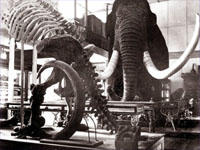 |
|
Brooks Hall contained 25,000 specimens, among the best owned by any college in the nation. Photo courtesy of Small Special Collections Library. |
Visitors to the University of Virginia in 1877 were amazed at the 16-foot-tall, life-sized replica of a woolly mammoth displayed in one of its buildings on Grounds. Initially, newcomers to the University were met with the stunning architectural beauty designed by founder Thomas Jefferson. His unique form of Neo-Classicism could be seen at every turn, which made it shocking to see an out-of-place, three-story Gothic structure just yards away from the Rotunda at the epicenter of the University.
The “Lewis Brooks Hall of Natural Science,” now known simply as Brooks Hall, opened in 1877 as one of the few museums of natural history in the United States. Its walls were adorned with carved animal heads, its exterior engraved with the names of prominent natural historians, and its main hall overwhelmed by wildlife dioramas, which included a Siberian mammoth and South American glyptodon.
Before its unveiling to the public, a group including President Rutherford B. Hayes was given an early tour of the museum where “the whole party seemed to be very much interested in what they saw,” according to newspaper accounts. But if he had just taken a peek outside its windows to the sloping field that fell toward the Corner, he may have had an even more curious reaction to a group of students, huddled together, chasing after an odd-shaped leather ball.
One of the early references to football at UVa, in the October 1872 edition of the University Magazine, describes a scene on the hill next to Brooks Hall (No. 3 on this map):
“While strolling in a meditating mood down to the post-office, we were attracted by a crowd of coatless youths … engaged in what seemed to us the insane sport of madly rushing together and trying to kick each other’s hats off … We asked of a friend near us what was the matter? He replied: ‘Football.'”
“We were kicked on the shins, on the knees, in short on everywhere that we could possibly be kicked … Nevertheless, it is fine sport – to a looker-on. So keep it up, gentlemen, and hereafter your editor will tenderly watch over you – from the top of the fence.”
And look on they did – for the next century and more. The story of football at the University of Virginia (which will be covered in my upcoming documentary Wahoowa: The History of Virginia Cavalier Football, due out this fall) would not be complete without an account of the various fields in which the sport was played and viewed.
Ken Burns’ magnum opus Baseball devotes a chapter to the birthplace of the modern version of the sport, the “Elysian Fields” – not of Greek Mythology, but of Hoboken, New Jersey. A historical marker, today resting in a busy intersection of the town, is the only trace of this significant baseball diamond. UVa football’s version of this hallowed ground is appropriately located on – you guessed it – the Lawn (between No. 31 and No. 34 on this map).
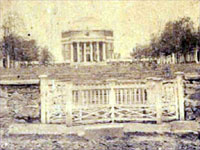 |
|
The Lawn in 1868. Photo courtesy of Small Special Collections Library. |
The very first account of football at UVa describes what could be considered an intramural game that took place on the Lawn in 1870. Angered when a math lecture had been canceled, sounds of swearing amongst the boys returning to their rooms turned to grunts and groans as they started a game of football – more likely to be the “kicking game” that had been established the year before between Rutgers and Princeton.
Probably at the behest of professors who held classes in the Pavilions on the Lawn, games soon moved to “the area between the orchard and the laboratory,” according to Philip Bruce’s history of the school. Alumni will know this as the area across from the West Range where Monroe Hall (No. 26 on this map) now stands. No doubt some irony comes from the fact that this was the home of the Commerce School for many years, considering the “big business” that college football has now become.
Informal games, sometimes consisting of 100 players to a side, continued in these locations until 1887, when a more formal football team was established -one that sought outside competition (which I’ll delve into more in the documentary film). It was then that a new playing field was needed on Grounds.
One account – from dear friend and longtime UVa Media Relations luminary, the late Michael Colley, who was a walking encyclopedia of UVa sports history and an invaluable resource in my research – describes the first official Virginia team as having “opened its season on a gravel-strewn field … witnessed by a sparse gathering of fans and no press coverage … on a five-acre tract behind what is now Madison Hall.” UVa alumni as well as patrons of the historic Easters celebrations will recognize this description as Mad Bowl. While no formal account of this location can be found, I’m going with my gut that Michael knew what he was talking about.
Mad Bowl (No. 17 on this map) wasn’t always a “bowl” though – and it wouldn’t be called Mad Bowl until the next century. At one time it was a hill that sloped down from Madison Lane, current home to several fraternity and sorority houses, to Rugby Road. In 1853, needing more classroom space, University officials began planning the construction of the Annex to the Rotunda, which years later was destroyed in a fire.
In order to build this addition, the slope between the back of the Rotunda (where the Statue of Jefferson now presides) and University Avenue would need to be leveled. Earth was excavated from across the street, creating this “gravel-strewn field.” It was here that some of the first official football games might have been played.
But as the “business” of college athletics crept into Charlottesville, a problem arose with the several fields being used for football. Anyone could watch the games. There was no way to charge admission when passersby could walk up and watch, or look out from a house on Madison Lane, as was the case with the Mad Bowl field.
While it may seem that the business of football began as a way for universities to fill their coffers, the original need to charge admission was to pay for the costs of uniforms, equipment, and travel. It was typically up to the students themselves, or the generosity of the faculty, to fund the football team. So in 1888, in order to make the operation a little more self-sufficient, a law school professor named Felix H. Levy proposed to build a fence around “the ball grounds” to house both football and baseball activities.
While games had been played where Brooks Hall now stands, it was too sloped. And the field where Monroe Hall has since been built would be used for a house built by chemistry professor John W. Mallet. And the field at Mad Bowl was too muddy and too difficult to fence in. What a blight on the Grounds it would have been to see a large wooden fence erected so close to the Rotunda.
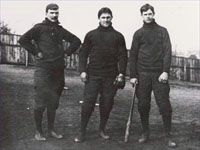 |
|
UVa baseball players at the “Athletic Field” near Montebello in 1897. Photo courtesy of Small Special Collections Library. |
There was one other playing field in the vicinity of the Grounds that Felix Levy thought would work just fine. This area was used for baseball games and other sports, but was not the official football field. It was located southwest of the Lawn, roughly where Jefferson Park Avenue, Emmet Street, and Stadium Road currently come together. The field was said to have been “below Montebello,” which most likely meant the depression of land just north of the Montebello House (No. 32 on this map) built in 1830 by Captain John Perry, the original owner of the property Jefferson obtained to build his Academical Village. Today Montebello is used as lodging for distinguished faculty, and the old football field is most likely under an apartment building just down the hill toward Emmet Street.
But in 1888, this was perfect. It was just enough out of the way that a fence erected around this field would not be an eyesore next to the beauty of University architecture. Still, there was the matter of $1,000 in construction fees to pay for the project. Levy turned to a local businessman willing to roll the dice on a loan, with a lien on a percentage of the gate receipts as collateral.
The University administration gave their approval on the deal and watched nervously at the attendance for the first few games. After just a few events, they breathed a sigh of relief. This was a product for which the public was hungry. The football program would be on solid financial footing for the most part.
Levy was then appointed president – a de facto athletic director – of a newly formed athletic association and had the authority to appoint “committees” on football and baseball. He was also challenged by an unexpected situation with regard to his new football palace. According to College Topics, the predecessor to The Cavalier Daily:
“The silhouettes of many dwellers on Dawson’s Row (approximately where Kerchof Hall, No. 22 on this map, now stands) were conspicuously visible from the ball park during a recent game. We could not but fear that these Dawsonians while thus cheating the management of the ball team by looking on from a distance, would at the same time injure their eyesight by such constant strain; and hence we suggest that they will find much better positions in the trees to the South of the athletic field.”
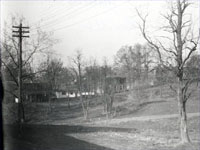 |
|
Dawson’s Row in 1900 near Emmet Street. Photo courtesy of Small Special Collections Library. |
Only a few years into its run as the official football arena, students began calling for a better athletic field for football and baseball practice, along with tennis and track. The “Montebello Field,” for lack of a better name (there was no official name for it that we can find), was becoming too small for the growing crowds that were packing the games.
As luck would have it, the Mad Bowl field had just been purchased by the student-run YMCA, and $4,000 was spent to level the field. After using pick axes, shovels, and even blasting powder to finish the job, the newly christened “YMCA Campus” would open in 1892 with a gorgeous new playing surface.
And in 1893, on just the other side of Rugby Road, work would be completed on Fayerweather Gymnasium, which became the largest indoor athletic facility in the South – today it’s an art museum called Fayerweather Hall (No. 10 on this map). The YMCA Campus combined with Fayerweather Gym became a sports hub of the University in the 1890s … but not for football games. The problems that prevented building a fence and charging admission still remained. So while football practices were often held there, officials began working on yet another home for the varsity eleven.
In 1901, work began on a 21-acre plot northwest of the YMCA Campus, in an area that had been part of the Rugby Dairy Farm. Named in honor of Dr. William Lambeth, superintendent of buildings and grounds and the “father of athletics” at UVa, Lambeth Field (No. 13 on this map) opened in 1902 as the home to many sports. The Montebello Field had served its purpose for 14 years, but the new location had room for all. Fans were encouraged to attend the games in wagons or horse-and-buggies so as to get a better view of the action.
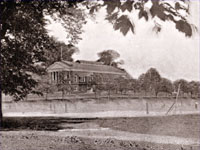 |
|
The YMCA Campus field later known as Mad Bowl and Fayerweather Gym in 1897. Photo courtesy of 1897 Corks and Curls. |
In subsequent years, UVa’s football team became one of the best in the nation. While AP rankings would not come into place until 1936, many of UVa’s teams during this era would have undoubtedly finished in the top five in the country. From 1908-1915, its teams ended seasons five times with only one loss.
- 1908 (7-0-1) – Allowed 9 points all season, in a 18-9 victory vs. St. John’s.
- 1909 (7-1) – Gave up only 11 points all season, in an 11-7 loss to Lehigh.
- 1911 (8-2) – Two losses by a total of 10 points.
- 1913 (7-1) – Only loss 8-7 at Georgetown.
- 1914 (8-1) – Only loss at Yale.
- 1915 (8-1) – 1st Southern team to beat Yale, only loss at Harvard.
In March 1909, College Topics reported “Improvements on an extensive scale are being made by the General Athletic Association on Lambeth Field … the G.A.A. proposes to erect a handsome clubhouse to be located on the hilltop overlooking the athletic field.”
It would take four years, but in 1913, the crude wooden bleachers that had been constructed after the initial opening of Lambeth Field were demolished, and a more classical stadium with an impressive 8,000-seat capacity, the Lambeth Colonnades, was built for $35,000. Season tickets went for $7.50 for students and $9.50 for alumni.
A contest against Vanderbilt University opened the new stadium. Billed as the “Football Classic of the South,” trainloads of alumni poured into Charlottesville to watch Virginia take a commanding 34-0 decision from the Commodores. That season saw Virginia outscore its opponents 265 to 28, with the team’s lone loss coming in an 8-7 defeat at Georgetown.
From the first recorded scores of games until 1915, spanning a period of almost 30 years, UVa did not experience a losing season, only doing so in 1916 with a 4-5 record. Virginia became the powerhouse of the South. During WWI, UVa football took a hiatus, although when it returned two years later, it was mired in a decade of records that generally hovered around .500.
By the spring of 1930, Lambeth Field had become run-down and too small to contain all of the athletic teams vying for room. Spring practice was stopped, as footballers complained of javelin and discus throws coming dangerously close to the action. The University would begin negotiations for yet another football field, and Scott Stadium (No. 8 on this map) would open in October 1931. Named for the donor of the land and rector of the University, Frederic Scott, it boasted a crowd of 25,000 when it opened.
Despite the beauty of this glorious new stadium, modern-day fans would be shocked to see the pre-game entrance of the teams as they simply walked in from the open end of the stadium opposite “The Hill.” No locker rooms existed yet as Bryant Hall would be decades away. Spectators at the time would heckle opposing teams as they sat in the grass outside the stadium for their halftime strategy sessions.
In 1981, Scott Stadium was expanded to include upper decks, something Felix Levy and the Montebello Field operators could not dream of in the 1890’s. And a more manicured version of The Hill allowed for additional seating, increasing capacity to 41,000.
This fall marks the 10th anniversary of the most recent expansion of Scott Stadium (Check out Scott Stadium through the years!). In 2000, the generous donations of alumnus and former football player Carl Smith led to the completion of a horseshoe that connected the upper deck and south end zone seating, taking capacity to 61,500. Along with the upgraded field, funded by David A. Harrison to replace the aging Astroturf, and HooVision, a state-of-the-art scoreboard and video screen upgraded just last year, Scott Stadium is one of college football’s most beautiful settings.
While UVa’s first football field does not have the ear-pleasing ring of baseball’s Elysian Fields, its lack of a proper name, or even a historical marker, does not diminish its significance to Wahoo fans. Our Collegian Fields are right under our feet when we stroll across the Lawn, or to the Corner past Brooks Hall, or through the academic center by Monroe Hall, or to the Lambeth dormitories, or even through the Montebello Circle neighborhood.
A woolly mammoth made its presence felt on University visitors for more than 70 years, but football has endured for almost twice that span. Residents of the University community as late as 1948 would mockingly say of Brooks Hall, “Oh, that’s the building with the elephant.” But now, hopefully, a walk past it today will conjure thoughts of the football pioneers that kicked each other’s hats off, chasing an odd-shaped leather ball.
About The Author: Kevin Edds is the Writer/Director of the upcoming documentary Wahoowa: The History of Virginia Cavalier Football, set to be released this November. For more information on the film, please visit www.UVaFootballHistory.com. TheSabre.com is pleased to introduce a new series on the history of UVa football where Edds, an alumnus, will highlight some of the most interesting moments in the more than 120-year history of the South’s oldest football program. Email Kevin here.



